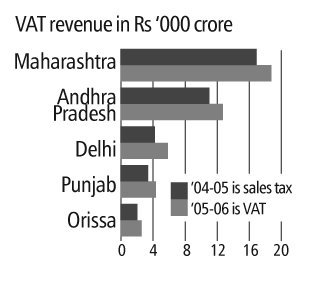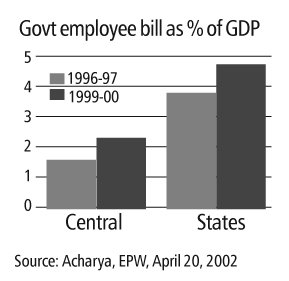Intro: For every success, the UPA's chalked up stunning failures, the impact of which will mostly be in the future.
|
| |
| When the very first “major decision” listed by a government in its first anniversary-booklet is ‘allowing Indian Oil Corporation to charter ships for oil imports directly instead of going through Transchart, an agency under Ministry of Shipping’, and the second is to set up a monitoring committee to oversee the filling up of the backlog of government posts reserved for SC/ST, you can’t really expect too much by was of reforms. You can blame it on an unimaginative Press Information Bureau, and there is no denying this year’s record is a lot better, but most successes over the government’s two year tenure so far, have been over-shadowed by equally bad policy decisions. Some such as reservations in colleges, and possibly in private sector jobs, it is true, have not been endorsed by the Cabinet as yet, but the public outcry over them has drowned out even the good work. |
| |
| For every sin of commission there is an equally serious sin of omission, though it has to be said in the UPA’s defence, the NDA failed on each one as well. So, losses of the oil PSUs continued to mount even under the NDA which also refused to administer an earlier Cabinet decision to charge market prices for petroleum products - at Rs 73,000 crore for the year if prices don’t get hiked, the under-recoveries of the oil-PSUs are half the fiscal deficit. The Employee’s Provident Fund Organisation’s losses are mounting, but they were Rs 19,291 crore in 2002-03 as well. The raging Naxalite problem, which engulfs a fourth of the country is also something the UPA inherited. A look at the top four successes and failures, as the UPA celebrates its second anniversary. |
| |
Value Added Taxation:

The roadmap to VAT to replace the states’ sales tax was put in place by the NDA, but was never implemented. Despite major NDA states staying out, Finance Minister P Chidambaram implemented VAT. While sales tax collections of states were growing by around 13 per cent earlier, this rose to over 14 per cent under VAT — this, despite the ceiling rate falling from 17 per cent in the case of Mahrashtra, for instance, to 12.5 per cent. Now, the BJP states also want to join the VAT group. |
| |
Correct flight path:
After the NDA’s open skies policy with Asean, this is the most significant reform the sector has seen — reportedly, the government is also looking at allowing foreign airlines to buy into local carriers. Unlike in the case of PSUs where the policy is to not privatise, the government withstood pressure from the Airport Authority of India unions as well the Left parties to privatise the Delhi and Mumbai airports. The process looked vitiated with the Planning Commission pointing to the huge real estate play in the airports, as well as the flawed marking. The government sailed through by removing the excess real estate and appointing a neutral committee to examine the charges and find a solution. |
| |
Fiscal consolidation:

With the National Advisory Council’s huge shopping list (the rural employment guarantee itself could cost a potential Rs 40,000 crore), most expected the fisc to go for a toss. Finance Minister P Chidambaram surprised all by sticking to his deficit target and pruned down the shopping list by, for instance, implementing the employment guarantee in select districts. His ‘bad taxes’, also, have ended up with impressive collections of Rs 7,600 crore in 2005-06 itself. |
| |
Back on track:

Prime Minister Singh attracted a lot of flak for, first, retaining Lalu Prasad in this Cabinet and then giving him the Railways portfolio, given how Prasad ran Bihar into the ground. Under him, however, the Railways have turned around significantly, even if the buoyant economy played a huge role — Prasad’s decision to allow wagons to carry four tonnes more weight than earlier also played an important role in this. The policy to allow private players in the container freight business is another major step forward, with 15 firms vying to get a slice of this pie. |
| |
Reservations galore:

Medical students are on strike across the country and more trouble is expected when colleges re-open in July. The government hopes to buy peace by increasing the number of engineering and medical seats, but this could take 4-5 years. Interestingly, NSS data debunks the case for reservations. The share of OBCs in the labour force equals their share in popula- tion, showing they’re getting jobs. Their share in top jobs is similar to their share in the country’s college-enrolled population; and that, in turn, is determined by their share of the high-school passed population, making it clear that the problem lies at the school level. |
| |
Sins of Commission:

The proposed Sixth Pay Commis- sion poses the biggest danger to the dramatic turnaround in both Central and state finances. The previous Commission resulted in the combined government wage bill rising by 1.5 per cent of GDP, a figure equal to around half the hike in the fiscal deficit between 1996-97 and 1999-00. The last time around, the recommendation of downsizing government by a third never got accepted, and there’s little reason to believe things will be different this time around. |
| |
Who SEZ pay taxes?:
In principle, the move was to learn from the Chinese success, and provide hassle-free export zones of global standards. Since labour law restrictions remain the same as in the rest of the country, the success is dubious. The finance ministry has been opposing the generous tax incentives, and has tried to restrict them by increasing the minimum size of the zones — many fear export units will expand operations primarily in SEZs since non-SEZ exports are taxed right now. An empowered Group of Ministers is sup-posed to resolve these issues but its success remains limited so far. |
| |
Guaranteed disaster:

Since the UPA believes the country has seen jobless growth for many years, it decided to guarantee 100 days of employment to one adult member of each rural household. If only the poor opt for it, the costs could be as high as Rs 40,000 crore per year, but the actuals could be even higher since the non-poor are also eligible. The government hopes to contain this by merging existing schemes with it. The joker in the pack is the NSS data, based on small samples though, which shows jobs growth has picked up on its own. |
0 Comments:
Post a Comment
<< Home